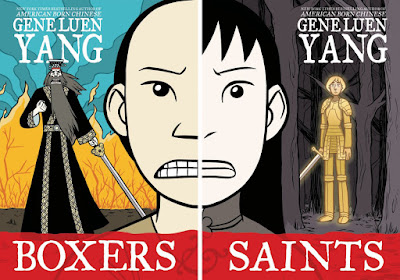Today, when our country feels so divided, I’m gonna
recommend a good book. Actually, two: a pair of YA graphic novels that tell the
same story from two opposing perspectives.
Gene Luen Yang’s Boxers and Saints, a 2013 National Book Award Finalist, can be read in either order; I read Boxers first. Set in Northern Shan-tung Province, China, in 1894, Little
Bao loves spring in his village because the festivals feature operas that
convey stories of gods and heroes through costumes and music.
But when foreign missionaries and soldiers begin bullying
and robbing Chinese peasants, Little Bao’s brothers begin to train in kung fu
with Red Lantern Chu—and so does Little Bao, in secret. Over time, Little Bao
gains the ability to harness the powers of Chinese gods as he assembles a
people’s army to free China from “foreign devils”: the real-life Boxer Rebellion.
Battle scenes are gorgeously rendered, vivid and violent,
with gods and humans engaged simultaneously. Yet Yang also demonstrates Bao’s
growing unease as he recognizes the humanity of the people he’s killing. Bao
must make increasingly awful decisions: what should he, as the army leader, do
about Chinese peasants who have converted to the foreign religion? Is the “glory
of China” worth killing innocents for?
In the other volume, Saints,
a young girl grows up unappreciated and unwanted—her family doesn’t even bother
giving her a name, calling her Four-Girl because she is the fourth daughter.
Her vibrant personality makes her sympathetic and lovable—even when she decides
that she might as well be evil.
When she’s 8 years old, Four-Girl is taken to a Christian
healer because she keeps making a face like a horrible mask. Dr. and Mrs. Wan
treat Four-Girl well, telling her stories about Christianity. Four-Girl begins to
have visions of Joan of Arc, who encourages Four-Girl to believe in something
bigger than herself.
Finally finding a place where she belongs, Four-Girl chooses
a name—Vibiana—when she converts to Christianity and leaves her family. Anyone who
has created their own family or found a new home will relate to Vibiana’s
newfound peace, as well as her struggles to simultaneously embrace and leave her past.
But the Boxer Rebellion is underway, with young men (and
women) throughout the countryside murdering Westerners and Chinese Christians
alike. It’s fascinating to see the same characters—heroes in Boxers—as villains to Vibiana and her
friends. Vibiana has friends and family on both sides of the conflict. Although
she admires Joan of Arc’s sacrifices, Vibiana is unsure: can she give her life
for a cause? And if she does, which does she choose, her country or her faith?
By portraying both sides of a historical conflict, Yang shows
that there are no “good guys/bad guys”; it’s all perspective. He humanizes
people trapped on both sides, demonstrating that the lines between them are blurred.
I found this pair of books engaging, diverting, and hopeful
as our country attempts to resolve its differences. They reminded me that we may be
more alike than we think, if we can see each other as individuals with hopes and dreams for our futures.

No comments:
Post a Comment